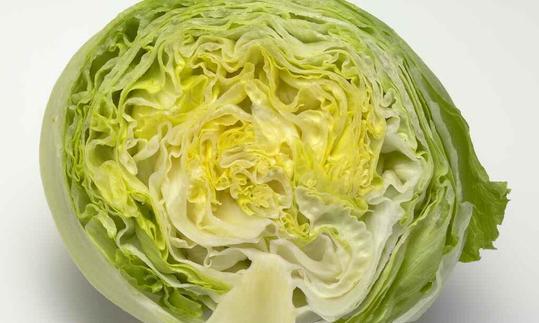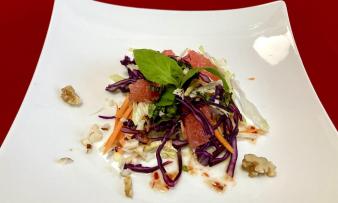Table of contents
Iceberg lettuce or ice cream lettuce ( Lactuca sativa var. capitata nidus tenerimma, Crisphead group) is low in calories but contains few vitamins and nutrients.
Use in the kitchen
Iceberg lettuce is characterized by very firm, closed heads. The leaves are dark green on the outside and become lighter towards the middle. The inner leaves in particular, which can no longer unfold, are crisp and mild in taste. The Batavia lettuce, which belongs to the Crisphead group, has an open head and curled leaves.
Iceberg lettuce combines well with other salads, such aslettuce or romaine lettuce, as well as any kind of raw vegetables. Ingredients with a more intense flavour such as radish, radishes, rocket or romaine lettuce are ideal. However, it also goes well withsweetcorn and cherry tomatoes. An oil-free Salad dressing can easily be made with walnuts - either as a light vinaigrette with balsamic vinegar or as a dressing with orange juice and ginger. Alternatively, you can also make an oil-free dressing from avocado and lemon. Ingredients with earthy notes, e.g. walnuts, hazelnuts, potatoes or lentils, can refine the vegan salad.
Garnished with grilled vegetables such as eggplant, zucchini and sweet peppers and optionally supplemented with cashew cheese or vegan mozzarella, iceberg lettuce is a varied main meal. Iceberg lettuce, tomatoes and onions together with a raw vegan patty made from sweet potatoes or Portobello with eggplant make a delicious vegan burger .
Iceberg lettuce can also be used for vegan raw food smoothies, such as the apple-banana smoothie with spinach and lettuce.
Vegan recipe for summer rolls with iceberg lettuce and vegetables
Ingredients (for 4 servings): 15 sheets of rice paper, 1 iceberg lettuce, 2 carrots, 1 cucumber, 1 avocado, 1 mango, 50 g coriander leaves, 1 handful of sprouts ( mung bean sprouts or alfalfa sprouts).
Preparation: Wash the iceberg lettuce, spin dry in the salad spinner and cut into strips. Wash the carrots and cucumber and cut into strips. Peel the mango and avocado and cut the flesh into strips. Wash the coriander leaves and chop roughly. Wash the sprouts and dry them well. Fill a large plate with water. Pull a sheet of rice paper through the water and place it on a plate or board. Place the ingredients in the middle of the sheet. Fold the right and left outer sides of the rice paper over the filling. Then fold the bottom side of the rice paper over Place the filling, roll the sheet up tightly from bottom to top and press the seam firmly. Repeat the process with the remaining rice paper sheets.
Miang Kham sauce ( ingredient notes), soy sauce or an oil-free vinaigrette are suitable as a dip for the summer rolls.
Vegan recipes with iceberg lettuce can be found under the note: " Recipes that have the most of this ingredient ".
| Not only vegans or vegetarians should read this: Vegans often eat unhealthily. Avoidable nutritional errors. |
Shopping - Storage
Iceberg lettuce can be found in large supermarket chains such as Coop, Migros, Denner, Volg, Spar, Aldi, Lidl, Rewe, Billa, Edeka or Hofer, sometimes also in controlled organic quality (organic quality). Also in organic You can sometimes buy iceberg lettuce in supermarkets such as Denn's Biomarkt or Alnatura, as well as seasonally at the weekly market. In Central Europe, iceberg lettuce has its main season from May to October as an outdoor product. Outside of the season, the lettuce is grown in greenhouses, which is why it can be grown almost all year round. about in stores.
The availability of iceberg lettuce in the supermarkets mentioned varies depending on the size of the store, catchment area, etc. If you are interested, click on our recorded food prices for the DA-CH countries (above under the ingredient image). There you will find current prices from various supermarkets and their price development.
Storage tips
Compared to other lettuces, iceberg lettuce can be stored for a long time and remains crisp. In the vegetable compartment of the refrigerator and wrapped in paper, foil or a damp tea towel, iceberg lettuce will keep for around 1 to 2 weeks after harvest. 1
Ingredients - Nutritional values - Calories
Iceberg lettuce (raw) contains 14 kcal per 100 g and is therefore very low in calories. It consists mainly of water. The protein content is low at 0.9 g/100g and fat is also low at 0.14 g/ 100g barely present. Of the 3 g/100g carbohydrates, 2 g are sugar. 2
Does iceberg lettuce contain fiber? Iceberg lettuce contains little fiber, at 1.2 g/100g. Endive and chicory have significantly more fiber, both containing 3.1 g of fiber per 100 g. 2
Raw iceberg lettuce contains 24 µg/100g of vitamin K (32% of the daily requirement). Compared to other salads, this is little.Lettuce and romaine lettuce contain 102 µg/100g and rocket 109 µg/100g, which is around 136% and 145% of the daily requirement, respectively. daily requirement of vitamin K. More vitamin K is contained in kale (705 µg/100g) and chard (830 µg/100g), both of which can also be eaten as a salad. 2
Green salad is known for its high content of folate (folic acid). However, unlike other salads, iceberg lettuce contains little of it: 29 µg/100g, which makes up 15% of the daily requirement. There is also little folate inlettuce (73 µg/100g). In contrast, romaine lettuce with 136 µg and endive with 142 µg contain a lot of folate. With 100 g of romaine lettuce you can cover 68% of your daily folic acid requirement, with 100 g of endive even 71%. 2
Potassium is also present in iceberg lettuce with 141 mg/100g, which covers 7% of the daily requirement. More potassium is found inlettuce (238 mg/100g) and in romaine lettuce (247 mg/100g). Much higher values are found in rocket with 369 mg and Lamb's lettuce contains 459 mg per 100 g. This corresponds to a coverage of 18% and 23% of the daily requirement. Good sources of potassium are pulses and nuts, for example almonds (733 mg/100g) or chickpeas (718 mg/100g), which contain 37 % or 36 % of the daily requirement. 2
You can find all the ingredients of iceberg lettuce, how much it covers your daily needs and comparison values with other ingredients in our nutrient tables below the ingredient image.
Effects on health
How healthy is iceberg lettuce? Iceberg lettuce contains few calories and can therefore help you lose weight. Studies show that a large portion of lettuce eaten without any other ingredients and with a low-calorie dressing before the main meal helps you lose weight in the long term. By eating of the salad, you eat less of the main meal, which reduces the total amount of calories consumed per meal. 5 Since iceberg lettuce contains little fiber, unlike other leaf lettuces, it is best combined with fiber-rich varieties such as endive and chicory.
Dangers - Intolerances - Side effects
Ice leaf lettuce contains nitrate like other leaf and root vegetables, as it needs this as a source of nitrogen for growth. In contrast to other leaf lettuces, however, this is rather small. 16
Nitrate is converted to nitrite in food or in the body. 3 High nitrite levels are problematic for infants, as they can disrupt the transport of oxygen in the blood. 6,15 Adults have less to fear from this effect of nitrite on the blood. Nitrite can also be combined with with certain amino acids to form so-called nitrosamines, which are considered carcinogenic. 6 This is why nitrate and nitrite have fallen into disrepute. However, if the nitrate in the diet comes from vegetables, it also has numerous positive effects on health (for more information, see Batavia lettuce). 13 If you still want to consume as little nitrate as possible, you should prefer seasonal organic iceberg lettuce (more on this under cultivation harvest).
Ecological footprint - animal welfare
The ecological CO2 footprint of iceberg lettuce is between 0.5-0.6 CO 2 eq per head of lettuce. The lettuce is usually grown outdoors, which in itself saves emissions from operating and heating greenhouses. However, the Young plants of spring lettuce, which is available as early as May, come from heated greenhouses, and their ecological footprint is correspondingly higher than that of summer lettuce. In addition, fleece coverings are often used to protect spring produce from the weather. 19
The amount of water needed to produce 1 kg of lettuce is quite low at 237 litres and is similar to that of spinach (292 litres) or onions (272 litres). 20 When shopping, it is best to look for regional, organically grown produce, ideally unpackaged iceberg lettuce. This saves the often used plastic packaging and you can store the iceberg lettuce (see storage tips) in the fridge for a long time without unnecessary use of plastic. In order to keep the ecological footprint as small as possible, it is best to only buy iceberg lettuce from June onwards. 19
In order to meet agreed delivery quantities and deadlines, iceberg lettuce producers calculate with a sales quota of around 70 percent. This also takes into account failures and damage caused by wild animals, weather events, rot, etc. This can, however, lead to an oversupply of iceberg lettuce. In this case However, you can simply leave the lettuce in the fields and work it into the soil as a natural fertilizer. 18
Worldwide occurrence - cultivation
W. Atlee Burpee & Company (now Burpee Seed Co.) first cultivated iceberg lettuce in the USA in 1894. In contrast to Batavia lettuce, which also belongs to the Crisphead group, iceberg lettuce has a firm, closed head. 7
Iceberg lettuce and other leaf lettuces are grown worldwide, with China, the USA and India being the main growing areas in 2020. 17 In Europe, iceberg lettuce is mainly grown in Spain, Italy, France and southern Germany. 1 Iceberg lettuce is the most consumed lettuce in Switzerland. 12
Found in the wild
Iceberg lettuce is a cultivated group of varieties of garden lettuce ( Lactuca sativa) that does not occur in the wild. Cultivated garden lettuce can be traced back to several wild forms, with spiny lettuce ( Lactuca serriola) being the closest relative. 10 This grows in the warm temperate Zones of Southern Europe and Western Asia, but is spreading further and further into Northern Europe. 11
Cultivation - Harvest
Iceberg lettuce can be grown well in the garden bed, balcony box or in a pot. It prefers a sunny to partially shaded location. The soil should be loose and permeable, and have a high humus and nutrient content. Iceberg lettuce can be grown indoors or outdoors from the end of February. The seeds are sown outdoors and the seedlings are planted out from mid-May. Iceberg lettuce can be sown and planted out until the end of July. The seeds are sown in seed furrows with a depth of 0.5 to 1 cm and a distance of 25 to 30 cm. cm. Lettuces are light germinators, which is why they should only be covered very lightly with soil. If necessary, separate young plants. Regular watering, weed removal and loosening the soil are important for the lettuce to grow well. 1 After a relatively long cultivation period of eleven to twelve weeks, The iceberg lettuce is ready for harvest. Production is complex because the lettuce cannot (yet) be harvested mechanically. At the moment, lettuce is still harvested by hand. 14 As soon as the leaves around the head are fully developed, the lettuce can be harvested whole. To do this, use a sharp knife to cut off the head and stalk just above the ground. 1
Organically grown iceberg lettuce contains lower nitrate levels than conventionally grown lettuce because synthetic fertilizers are not used. Seasonal organic iceberg lettuce grown outdoors also contains less nitrate than that grown in a greenhouse because sunlight breaks down the nitrate stored in the lettuce. 4
Further information
Iceberg lettuce ( Lactuca sativa var. capitata nidus tenerimma) belongs to the genus of lettuce ( Lactuca), which belongs to the daisy family (Asteraceae). Cultivated garden lettuce is divided into several groups: Crisphead group (iceberg lettuce and Batavia lettuce), Cos- Group ( romaine lettuce) and Butterhead group (head lettuce). The cut and picked lettuces (e.g. oak leaf and Lollo rossa/bionda) are also becoming increasingly popular. 1
Why is iceberg lettuce called 'iceberg lettuce'? Bruce Church, founder of Fresh Express, was responsible for popularizing the idea of transporting lettuce from the west to the east coast of the USA. To ensure that it arrived fresh even after thousands of kilometers, the crisphead lettuce heads were covered with ice. The name iceberg lettuce quickly became established among consumers; Church may have invented it himself for marketing purposes. 8,9
Alternative names
Iceberg lettuce is also called Eissalat, Krachsalat or in Austria Bummersalat. In English it is called Iceberg Lettuce or Crisphead Lettuce.
Bibliography - 20 Sources
| 1. | Planatura.garden. Eisbergsalat: Alles zu Anbau & Ernte des gesunden Salates. |
| 2. | USDA United States Department of Agriculture. |
| 3. | BfR Bundesamt für Risikobewertung. Fragen und Antworten zu Nitrat und Nitrit in Lebensmitteln. 2013. |
| 4. | Pini U. Das Bio-Food Handbuch. Kleemann: Hamburg, Potsdam. 2014: 509-512, 639-640. |
| 5. | Rolls BJ, Roe LS, Meengs JS. Salad and satiety: energy density and portion size of a first-course salad affect energy intake at lunch. J Am Diet Assoc. 2004 Oct;104(10): 1570-6. |
| 6. | Biesalski HK, Grimm P. Taschenatlas der Ernährung; 6. Auflage (2015); Georg Thieme Verlag, Stuttgart und New York. |
| 7. | Burpee.com Lettuce, Iceberg A. |
| 8. | Freshexpress.com Our history. |
| 9. | Kitchenproject.com The History of Iceberg Lettuce. |
| 10. | Křístková E, Doležalová I, Lebeda A et al. Description of morphological characters of lettuce (Lactuca sativa L.) genetic resources. Hort. Sci. (Prague), 2008,35: 113-129. |
| 11. | D'Andrea L, Meirmans P, van de Wiel C et al. Molecular Biogeography of Prickly Lettuce (Lactuca serriola L.) Shows Traces of Recent Range Expansion. J Hered. 2017 Mar 1;108(2): 194-206. |
| 12. | Bauernzeitung.ch. Wissenswertes zu Schweizer Salaten - mit Rezept. 2020. |
| 13. | Guimaraes DA, Batista RIM, Tanus-Santos JE. Nitrate and nitrite-based therapy to attenuate cardiovascular remodelling in arterial hypertension. Basic Clin Pharmacol Toxicol. 2021 Jan;128(1): 9-17. |
| 14. | Pflanzenforschung.de. Rollen bald Köpfe? Roboter als Helfer bei der Salat-Ernte. 2019. |
| 15. | World Health Organization. Evaluations of the Joint FAO/WHO Expert Committee on Food Additives (JECFA). Sodium Nitrite. |
| 16. | Bayerisches Landesamt für Gesundheit und Lebensmittelsicherheit. Nitrat – Welche Salatarten enthalten wie viel? – Untersuchungsergebnisse 2015. |
| 17. | FAOSTAT Food and Agriculture Organization of the United Nations. Lettuce and chicory (2020). |
| 18. | Landschafftleben.at Salat Nachhaltigkeit. |
| 19. | Müller-Lindenlauf M, Zipfel G, Rettenmaier N, Gärtner S, Münch J, Paulsch D, Reinhardt G. CO2-Fussabdruck und weitere Umweltwirkungen von Gemüse aus Baden-Württemberg. 2013. |
| 20. | Mekonnen MM, Hoekstra AY. The green, blue and grey water footprint of crops and derived crop products. Hydrol. Earth Syst. Sci. 2011; 15: 1577-1600. |










Comments